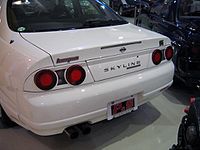
Nissan Gt-r R33 1995- 1998

The E-BCNR33 (R33) was developed in 1995 as a successor to the R32 model.
The engine in the R33 was nearly identical to the R32. It used the same turbochargers and the same specification for the manual gearbox, although the syncros were stronger. The engine corrected the R32's weak oil pump drive collar, which tended to fail in higher power applications, by using a wider collar. The base model R33 GT-R weighs 1,540 kg (3,400 lb).
| Fourth generation (R33) | |
|---|---|
 |
|
| Overview | |
| Production | January 1995 – November 1998 |
| Designer | Kozo Watanabe |
| Body and chassis | |
| Body style |
|
| Layout | Front engine, all-wheel drive |
| Powertrain | |
| Engine |
|
| Transmission | 5-speed manual |
| Dimensions | |
| Wheelbase | 2,720 mm (107.1 in) |
| Length | 4,675 mm (184.1 in) |
| Width | 1,780 mm (70.1 in) |
| Height | 1,360 mm (53.5 in) |
| Curb weight | 1,530 kg (3,373.1 lb) |
The R33 GT-R launched in January 1995 with the base model GT-R and the V·Spec model. The V·Spec model weighed in 10 kg (22 lb) heavier, and had sportier suspension resulting in lower ground clearance. The V·Spec also featured the newer ATTESA E-TS Pro all wheel drive system, which included an Active Limited Slip differential. The V·Spec model also included a four-wheel independent channel anti-lock braking system.
At the same time as the release of the R33 GT-R and GT-R V·Spec, Nissan released the R33 GT-R V·Spec N1 model. Changes made in the R33 N1 are similar to those in the R32 N1. The car was made lighter by removing the ABS, air conditioning, sound system, rear wiper, and boot carpet. The R33 GT-R V·Spec N1 received the slightly revised R33 N1 engine.
The R33 ended production on 9 November 1998. The last one that rolled off the line came in a R34 colour, as it shared the same colour code.
1996 NISMO - LM Limited
There were several limited editions of the BCNR33 produced by NISMO - Nissan's Motorsport division. The first, the LM version, was released in May 1996 to celebrate Nissan's participation in the 24-hours of Le Mans. The only body colour available for the R33 LM was Champion Blue. The car had a front splitter lip to direct air to the upper front aperture, and a carbon fibre rear wing with Gurney flap. There were carbon fibre inserts on the rear wing fins with a GT-R badge on the inserts. The "GT-R Skyline" logo under the checkered flag was placed on the C-pillars.
Nissan produced just 188 of this model, 86 GT-R LM and 102 V-Spec LM. Nissan entered two R33 GT-R cars in the 1995 Le Mans 24 hour race where the number 22 car finished tenth overall. This was remarkable considering it was essentially running the same RB26 motor and going up against supercars of that era like the mighty Mclaren F1 GTR.
- Limited Edition Factory fitted extras
- Championship Blue (code BT2).
- Carbon Fibre Rear Wing Blade.
- N1 Front Brake Cooling Ducts.
- N1 Bonnet Lip.
- Commemorative GT-R Decals on C-Pillars.
1997 NISMO 400R
For other uses, see 400R (disambiguation).A special edition R33 was released on November 3, 1997 called the 400R, with R standing for Racing. Overall development and planning was by NISMO (Nissan Motorsports International). But, its bored and stroked RB26DETT engine, the RBX-GT2, was engineered and produced by REINIK (later renamed REIMAX – "REINIK to the MAX"). The engine featured 77.7 mm stroke crankshaft (73.7 mm stock), forged 87 mm pistons (86 mm cast stock), upgraded rods, polished ports, high lift camshafts, upgraded oil system, larger exhaust manifolds and higher output turbochargers. NISMO produced an upgraded exhaust, a twin-plate clutch, and intercooler system. Nismo brake pads were fitted to the car. 400R exclusive aerodynamic updates were also added, such as wider fenders, side skirts, a new rear bumper, a new front bumper with bigger air scoops, and a redesigned bonnet and rear spoiler made of carbon fibre. The 400R was also fitted with 18x10 Nismo LM-GT1s. The car developed 300 kW (400 hp) and 347 lb·ft (470 N·m), which allowed a top speed of over 300 km/h (186 mph), and enabled it to reach 0–97 km/h (0–60 mph) in 4.0 seconds. 370 kW (500 hp) is easily achieved with a higher boost setting. NISMO had originally planned to produce 100 units of the 400R, however only 44 units were made before production of the R33 ended in 1998.

Skyline GT-R Autech 40th Anniversary Edition (Rear View)
Production figures
- GT-R (Series 1) = 5050
- V·Spec (Series 1) = 4095
- Unknown (Series 1) = 14 (Pre-production or early cars including GT-R, V·Spec and V·Spec N1).
- GT-R (Series 2) = 2291
- V·Spec (Series 2) = 1203
- LM = 188 (86 GT-R LM, 102 V·Spec LM)
- GT-R (Series 3) = 1958
- V·Spec (Series 3) = 1270
- Autech GT-R = 416
- N1 = 86 (Series 1 = 55 known, Series 2 = 21, Series 3 = 10)
- UK V·Spec = 103 (100x 17 digit VIN models plus 3 prototypes)
- Total production = 16,674
